Culture of Georgia
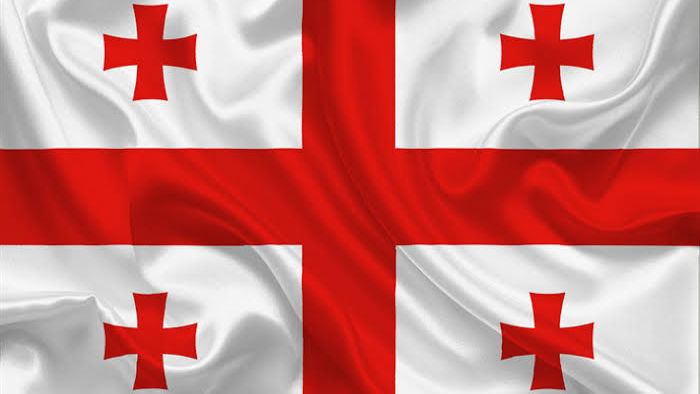
Culture Name
Georgian
Orientation
Identification. The term "Georgian" does not derive from Saint George but from the ancient Persian Gurg or Gorg, meaning wolf, "supposedly a totemic symbol, or from the Greek georgios ("farmer," "cultivator of land").
Self-identification is based mainly on linguistic tradition, and population groups that belong to different ethno-linguistic groups, such as Ossetians, Abkhazians, Armenians, Greeks, and Kurds, are not considered Georgian. There are some exceptions, such as Jews, who speak Georgian as a native language and have surnames with Georgian endings, but historically have had a distinct cultural identity. Georgians are subdivided into smaller regional ethno-cultural entities. All that have specific traditions and customs, folklore, cuisine, and dress and may speak a different language. Ajarans, unlike the Eastern Orthodox majority, are mostly Sunni Muslims. All these groups preserve and share a common identity, literary language, and basic system of values.
Location and Geography. Georgia is on the southern slopes of the Caucasus mountains, forming a natural border with the north Caucasian republics of the Russian Federation. The country, occupying approximately 27,000 square miles (69,900 square kilometers), stretches along the Greater Caucasus ridge, bordered by the Black Sea to the west, the Armenian and Turkish highlands to the South, and Azerbaijan to the east. The topography is varied. The northern region is characterized by high mountains, and the central and southern parts, while mountainous, are much lower and are covered with alpine fields and forests. In the east, the rivers all join the Mtkvari (Kura), forming the Caspian basin, while in the west, the rivers, of which the Rioni and Enguri are the largest, run into the Black Sea.
The climate is temperate and is more mild and humid along the western marine coast. Mountains create temperature zones that vary with elevation. The eastern plains and highlands, which are isolated from the sea, have a continental climate, while year-round snow and glaciers are found in the highest mountains. Climatic zones range from moderately humid Mediterranean, to dry-continental Arab-Caspian, and to cooler mountainous regions. Almost half the land is in agricultural use, with much of the remainder consisting of forests and high mountains. Land use varies with local climatic and soil patterns.
Tbilisi, the capital, was founded by King Vakhtang Gorgasali in the fifth century, and continues to be the most important political and cultural center of the country. Tbilisi is located in the culturally dominant eastern region, Kartli, on the banks of the Mtkvari (Kura), on the ancient crossroads of one of the great silk roads between Europe and Asia.
Demography. In the 1990s, the population was estimated to be from five to five and a half million, but reliable figures are not available because of extensive uncounted emigration. Just over half the population lives in urban areas, including 1.6 million in Tbilisi. Ethnic Georgians form the great majority of the population in most regions, though there are settlements of Armenians and Azeris in the south and the south-east, respectively; Ossetians in the north-central area; Abkhaz and Armenians in the northwest; Greeks in the southeast; and small numbers of Batsbi, Chechens, Ingushes, and Lezghs in the northeast. Russians and smaller ethnic minorities such as Kurds, Ukrainians, Jews, and Assyrians are concentrated mostly in urban areas. In the 1989 census, ethnic Georgians accounted for seventy percent of the population; Armenians 8 percent; Russians 6 percent, Azeris 6 percent, Ossetians 3 percent, and Abkhazians, under 2 percent.
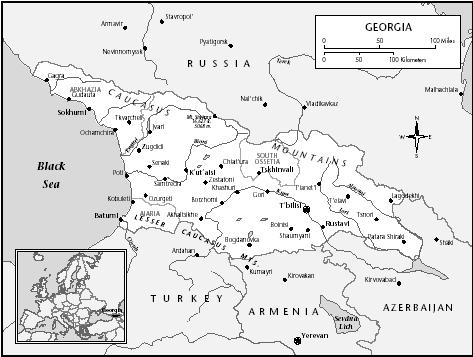
Georgia
This proportion has changed as a result of emigration among ethnic minorities, especially Russians, Jews, Greeks, and Armenians. Most ethnic Georgians were distributed throughout the country, while Abkhazians moved mostly to Russian cities and Ossetians took refuge in Northern Ossetia.
Linguistic Affiliation. The majority language is Georgian, which belongs to the Kartvelian (South Caucasian) language group. However, some subgroups speak other languages in the same linguistic group. The literary language comes from the Kartlian dialect spoken in the historically dominant eastern kingdom of Kartli. Georgian is the only Kartvelian language that is written and taught, and is the literary language used by all Georgians.
The principal minority languages are Abkhazian, Armenian, Azeri, Ossetian, and Russian. Abkhazian is, along with Georgian, the state language in Abkhazia. Most ethnic minorities in urban areas speak Russian rather than Georgian as a second language, but bilingualism and trilingualism are common, and Russian continues to be understood in most of the country. Russian, Armenian, and Azeri are used in schools and as official languages locally.
Symbolism. The competing impact of Asian and western cultures is most prominently expressed in Byzantine and Persian influences. Another overlap is between Christian and pagan, with a much weaker influence from neighboring Muslim patterns. Today, much cultural symbolism reflects a mythologized interpretation of tradition that is influenced by self-perception as belonging to European, Christian contemporary society.
Mythical symbols include the Golden Fleece of the Greek myth of the Argonauts' journey to Colchis and the mythical ancestor of Georgians, Kartlos. Other important mythical figures include Saint George, and Amirani, a noble hero analogous to Prometheus. Mythical symbols of the Abkhazians and Ossetians are both dominated by a mythical cycle dealing with the semidivine people of Narts.
The numbers seven and nine have symbolic meaning, as does the number three, which reflects the Trinity. The snow leopard and lion symbolize noble valor and vigor. The vine symbolizes fertility and the Dionysian spirit, and dominates medieval architectural ornamentation. A very important ornamental symbol is the fire-wheel swastika, a solar symbol traditionally used both as an architectural ornament and in wood carving as well as on the passport and currency. The Cross plays an equally significant role.
The hymn "Thou Art the True Vine" is the most important sacred song. National symbols often refer to language, motherland (national territory), and Confession (Christian Orthodoxy). The ideas of loyalty to kin, honor, and hospitality are held in high esteem. The characteristic metaphor is that of a mother. Other metaphors are linked to the sun, which is interpreted as a source of beauty and light, brotherhood, supreme loyalty, and victory.
State symbolism dates back to the Democratic Republic of Georgia (1918–1921). The most respected national festival (26 May) is linked to the declaration of independence in 1918. The national flag of black and white stripes against a dark crimson background and the state emblem, White George on horseback framed by a septagonal star, repeat the imagery of that period.
History and Ethnic Relations
Emergence of the Nation. Cultural unity was influenced by political unification and fragmentation. In the southern and eastern regions, the state of Kartli (Iberia) united tribes that spoke the Kartvelian language. The first attempt to unite the country occurred under King Parnavaz of Kartli at the beginning of the third century B.C.E. Georgia adopted Christianity in 334, when King Mirian III of Kartli-Iberia, following the instructions of Saint Nino of Cappadocia, declared it the state religion. The alphabet probably was created soon afterward to translate holy texts, replacing Aramaic and Greek scripts and producing both the hieratic script and the contemporary secular alphabet. The first Georgian inscriptions appeared in Jerusalem in the fifth century, followed by the first known literary text, the Martyrdom of Saint Shushanik. At about that time, King Vakhtang briefly united eastern and western Georgia. Several centuries later, the new dynasty of the Bagrations took control of the Inner Kartli and the city of Uplistsikhe, and in 978, King Bagrat III
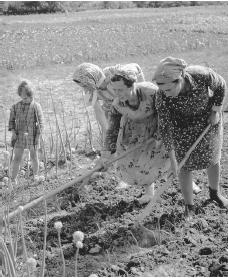
Women hoeing fields near Gori. There is no explicit division of labor by gender in Georgia, except for hard physical labor, such as mining.
Bagration became the first king of both Kartli and Abkhazia. In 1314, Giorgi V the Brilliant reunited Georgia after a long period of decline under the Mongols, but Tamerlain's invasions broke the nation's strength and unity. With the fall of Constantinople in 1453, Georgia became the only Christian stronghold in a region of Muslim kingdoms. In the beginning of the nineteenth century, Georgia was united by the Russian Empire, when the tsars Pavel and Alexander annexed the eastern region, abolishing the kingdom of Kartli-Kakheti.
After the Russian Revolution of 1917, Georgia declared independence in 1918, but the democratic Republic of Georgia, ruled by a social-democratic government, was invaded by the Red Army in 1921, a few days after it was recognized by European states. The Soviet Socialist Republic of Georgia retained formal sovereignty but was a puppet member of the Soviet Empire until its dissolution in 1991, when Zviad Gamsakhurduia proclaimed independence. By the end of that same year, Gamsakhurdia fell victim to a military coup. The military government, unable to cope with international isolation and an economic crisis, invited the former Soviet foreign minister Eduard Shevardnadze to become the chairman of the State Council, keeping real power in its own hands. After two years of civil war and secessionist conflicts in South Ossetia and Abkhazia, Shevardnadze took over the government. A new parliament was elected in 1995, a new constitution was adopted, and Shevardnadze was elected president. The self-proclaimed republics of Abkhazia and South Ossetia continue to be source of conflict, but negotiations on their status is ongoing and virtually no military action has taken place since 1993.
National Identity. The development of the nation is linked to the attempt to unite Georgia by King Parnavaz. However, at that time different parts of the country spoke different languages and had little in common. Western Georgia was inhabited by Colchian, proto-Abkhazian and proto-Svan tribes, with Greek settlements along the Black Sea shore, while in the eastern and southern regions the language was closer to contemporary Georgian, although part of the territory was inhabited by Turkic, Armenian, Alan, and Albanian tribes. Migration of eastern Georgian tribes to the west and the gradual assimilation of other ethnic groups in the east were accompanied by religious unity and unification under the Bagratid dynasty at the end of tenth century. During several centuries of common statehood, the Abkhaz, Armenians, Turks, and Ossetians partly preserved their cultural identities, while Albanians were fully assimilated.
Ethnic Relations. Sub-groups with common cultural identities experienced little conflict, although the medieval feudal system often caused internecine wars and warfare among ethnic kin. Today, despite mass migrations of Svans to southeastern Georgia and Megrel refugees from secessionist Abkhazia to other parts of the country, tensions have calmed. However, among the Abkhaz and Ossetians, tension and radical nationalism after the disintegration of the Soviet Union led to civil wars. There are some tensions with Armenians and between Azeris and Armenians in the rural southeast.
There are significant numbers of predominantly Muslim ethnic Georgians in Iran and Turkey. 100,000 Georgians have preserved their cultural identity in the small Fereydan region near Isfahan. Turkey controls a large territory with a traditionally Georgian population and numerous cultural monuments. These groups of Gürji, as they are called in Turkey, and Laz acknowledge their Georgian origin but have a strong sense of Turkish national identity.
Urbanism, Architecture, and the Use of Space
Settlements tend to be dominated by a church built on a hill nearby if not in the center. However, in the Soviet period, many churches were destroyed or turned into storehouses. Newly built churches are mostly poor replicas of older examples, primitive expressions of a declining tradition. Little is left of the medieval structure of small urban settlements surrounded by a citadel wall.
Urban architecture bears strong traces of Soviet influence. Government buildings and sculptures from the Soviet era are gloomy and pompous. These buildings have flat surfaces and enormous waste spaces in the form of colonnades or halls. In the 1970s and 1980s a new tradition emerged with more light and better use of space but was depersonalized and lacked creativity. Since independence, economic crises have precluded the construction of new government buildings. The older quarters in some cities are elegant and demonstrate an attractive mixture of European and Asian architecture. The majority of smaller towns are overgrown villages that show little effort to organize space or create an urban environment.
Rural architecture is typified by two-story stone buildings with large verandas. In the mountains, villages often are dominated by picturesque towers. Stone houses may surround a family tower or be organized in terraces with small gardens or yards. Traditional dwellings in the southern volcanic highlands were set deep in the ground and had no windows, with polygonal narrowing ceilings with a central opening for light and the exit of smoke. Internal space was organized around the fireplace below the roof opening, and a richly engraved central column played both a functional and a sacral role.
Food and Economy
Food in Daily Life. The greatest culinary divide is between the western and eastern region. In the west, there is a greater emphasis on vegetarian food, predominantly prepared with walnuts. Herbs and spices, especially tarragon, basil, coriander, feuille Grec, and pepper make western Georgian food hot and spicy. Cheese usually is made from cow's milk and is eaten with either corn bread or a corn and flour porridge. Khachapuri, a kind of cheese pizza, is common.
In the eastern area, the food is heavier, with more of an accent on mutton and pork. Wheat bread is preferred to corn, and sheep's cheese from
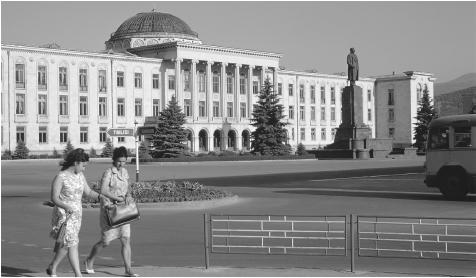
The municipal buildings in Gori. Local governments have small budgets and limited power but may be fairly independent in their policies.
Tusheti is popular. Among people in the mountains, the most popular food is khinkali, a cooked meat dumpling that usually is accompanied by beer. The most popular vegetables are tomatoes, potatoes, radishes, pumpkins, eggplant, beans, cucumbers, and cabbage. The most popular sauce, tkemali, is made of wild plums; other sauces are based on walnuts with spices, or pomegranate juice. Wine is drunk everywhere, and stronger alcoholic beverages include araki, which is made of grapes and other fruit with honey. Fish, especially trout, is eaten universally. A wide variety of locally grown fruit is supplemented by wild and cultured berries, watermelons and other melons. Dried fruit and nuts covered with a mixture of grape juice and wheat or corn flour are eaten in the winter. Jams are prepared from fruit, unripe walnuts, watermelon, eggplant, and green tomatoes.
Food Customs at Ceremonial Occasions. At the New Year's festivity, ground walnuts boiled in honey are served, along with a turkey or chicken in walnut sauce. An Easter meal includes hard-boiled eggs dyed red and other bright colors, roasted piglet and lamb, and special cakes with vanilla and spices. Special dishes are served at a wake: rice with mutton in the east, and meat with sweet rice and raisins in the west. Special wheat porridge with walnuts and honey is served forty days after a person's death.
Basic Economy. Georgians were basically rural people until the beginning of this century, when industrialization caused a mass rural-to-urban migration, especially to the capital. Most families are still linked through kinship relations with the countryside and preserve some traditions of their native localities.
Industrialization and the urban economy have had a limited influence on the national culture. Today, most of the population is urbanized and works in services or industrial production. Industry has been slow in recovering from the economic crisis of the early 1990s. Agriculture has been quicker to recover and accounts for almost 30 percent of the gross domestic product. A significant portion of exports consists of processed or raw agricultural produce such as hazelnuts, tea and wine. However, the country is not self-sufficient in producing grain as a result of the limited arable land.
Land Tenure and Property. After independence, much of land owned by the state was privatized. Over half the cultivated land was privatized by 1994, and that proportion continues to grow. However, in the highlands, where there is little cultivated land, privatization may entail restitution, as families respect traditional ownership. The state continues to control almost all uncultivated land, forests, and pastures; further privatization is expected in these areas.
Commercial Activities. Apart from agricultural goods, mineral water, soft drinks, and beverages, few goods are produced locally for the retail market. Cheaper goods from Turkey, Russia, China, and Bulgaria are sold in the shops. Some locally produced building materials, chemicals, and textiles are sold.
Major Industries. Major industries include metallurgy, metal and chemical works, mining (manganese, arsenic, copper, gold, oil, and raw materials for chemical production such as barite and mineral water), electronic devices, and machinery. A larger role is being played by transportation and especially transhipment because of the development of pipeline routes and transportation projects.
Trade. The principle exports are food, drink, tobacco, metals, and chemicals. The major imports are energy and fuel, mineral products, machinery, and food, drink and tobacco. There is a significant trade deficit. The main trading partners are Russia, Turkey, Azerbaijan, Turkmenistan, Bulgaria, the European Union, and the United States.
Division of Labor. High-paying jobs are available for those with a good command of English and advanced computer skills, while older people remain in poorly paid occupations. However, workers in their forties and fifties continue to occupy leading positions in ownership and management, as result of their advantage in starting capital and business connections from the Soviet era.
Social Stratification
Classes and Castes. The systems of social stratification changed significantly because of the increasing income gap between the impoverished masses and former white-collar workers, and the new rich, who have used financial and social capital to accumulate capital through privatization or trade, or have taken advantage of corruption in the state bureaucracy. Another change is linked to the restructuring of the political and economic system from the Soviet centralized type to a free market, although frequently the same Soviet bureaucrats and Communist officials have become capitalists and advocates of a liberal economy. Much of the new capital is concentrated in Tbilisi, Batumi, and the Black Sea port of Poti and thus is dominated by ethnic Georgians. The Armenian and Jewish economic elite that once played an important role, especially in Tbilisi, has lost its position because of emigration or because they maintain a lower profile.
Symbols of Social Stratification. An advanced position is expressed by a Westernized lifestyle. A Mercedes car symbolizes success, as do an apartment or house in a prestigious district, summering in France, and sending one's children to private European or American schools. Visiting casinos is another sign of upward social mobility.
Political Life
Government. Georgia is a presidential republic. The president is also the head of the executive branch, although the ministers are formally headed by the state minister. The single-chamber (225 members strong) parliament is elected in a mixed majoritarian-proportional system. The last parliamentary elections were won by the president's Citizens' Union of Georgia. The other two parties in the parliament are the Union of Industrialists and the Union of Georgia's Revival. The judicial branch, which was weak in the communist era, is in the process of being reformed. Local governments are partly elected and partly appointed from Tbilisi and have little formal power and small budgets. Depending on personal authority and local conditions, they may be fairly independent in their policies.
Leadership and Political Officials. Political parties, apart from the Union of Georgia's Revival, have little unity and lack well-defined political agendas. They mostly serve as instruments for pursuing a political career. Most parties tend to be social-democratic or moderately nationalistic. Personalities and personal connections play a decisive role in a political career, and the need to balance political issues and personal loyalty makes personnel appointments far from meritocractic. Many politicians are involved in economic activities, and this often creates conflicts of interest.
Social Problems and Control. Since the increase in crime during the civil wars and turmoil of the early 1990s, there has been a significant reduction in law violations and major crimes such as murder and burglary. The most socially dangerous crime is drug trafficking, which has increased the number of young drug addicts. Organized crime is another important concern. Corruption and incompetence in overstaffed law enforcement bodies along with a
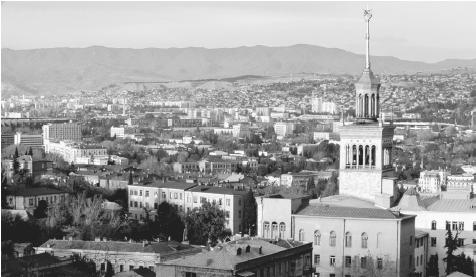
The Georgian capital of Tbilisi, which was founded in the fifth century by King Vakhtang Gorgasali.
weak judiciary system have made it difficult to fight crime. The general public is dissatisfied with the existing situation and with the system of law. Sometimes, especially in rural areas with a strong tradition of customary law, the community itself or a victim's relatives will take the law into their own hands and punish the perpetrator of a particularly shocking crime.
Military Activity. There has been little military action since the end of the civil war and the suspension of the conflict in Abkhazia, but the development of the nation's military potential attracts great attention from both the public and the government. Georgia participates in NATO's Partnership for Peace program and aspires to achieve closer cooperation, and even integration, with NATO. There still are four Russian military bases in the country, although their gradual withdrawal is under way.
Social Welfare and Change Programs
The state welfare system is inefficient, and has few resources. Pensions provide only a fifth of the minimum sustenance level, are poorly targeted, and cover too many beneficiaries. Much of the assistance goes to internally displaced persons from Abkhazia. A number of international and intergovernmental organizations are attempting to improve the welfare system.
Nongovernmental Organizations and Other Associations
There are thousands of non-governmental organizations (NGOs), but few of them are active and successful. NGOs participate in defending human rights and freedom of expression as well as environmental protection. However, as virtually all NGOs are funded by western sources, they have to adapt to the preferences and style of foreign funders, which often have only a vague understanding of the real needs of the country.
Gender Roles and Statuses
Division of Labor by Gender. There is no explicit division of labor by gender except in the areas of hard physical labor such as mining. The national culture places women in both the role of breadwinner and housewife. Most urban women work when they have the opportunity, although few have positions in the military and law enforcement. Top-level political and business jobs are less accessible for women, and only a few are in the government. No women can become a priest in the Orthodox church or a mullah among Muslims.
The Relative Status of Women and Men. The national culture strongly values respect for women. Legislation provides for a woman's right to take the children after a divorce. Women receive pregnancy leaves and earlier retirements and are not subject to military conscription. Although men dominate both public and family life, most housework is done by women. With many young educated women getting better paid jobs than their fathers or husbands, traditional stereotypes of gender-defined social roles are changing.
Marriage, Family, and Kinship
Marriage. Marriage is based on the free will of the partners and rarely is prearranged, although that sometimes happens in rural areas, especially in the Muslim population. Mutual attraction is the most common reason for marriage, although for older couples, economic benefits or comfort may be more important. In Muslim areas, unofficial polygamy exists in rare cases. There is a significant incidence of early marriage, but there is a general tendency for later marriage. Married persons who maintain a joint household have equal rights to their possessions.
Domestic Unit. The basic household in cities is the nuclear family, but frequently, grandparents live together with the family and help to bring up the children. In rural and mountainous areas, a few extended families exist, usually including several brothers with their parents and children. In this case the father of the family may control the resources, and assign tasks on the farm, while the mother is responsible for keeping the household. Younger members gradually split off, building a separate house in the neighborhood.
Inheritance. If there is no will after a person's death, the property is divided among all the children, including daughters, or among the closest relatives if there are no children.
Kin Groups. People ascribe great importance to kinship. Relatives up to the third or even fourth generation are considered close, and are expected to share both happy events and grievances. They meet regularly at important social events such as weddings and funerals, and neglecting the social duty to attend is disapproved. The kinship system played an important role in cushioning the effects of economic crisis when the social welfare system was disrupted. Extended kinship relations may create clientelism and protectionism as well as organized crime.
Socialization
Infant Care. Customary practices in the care of infants have been abandoned, such as the practice of rearing young infants in a special type of cradle that restricted the movement of a child. Children are the focal point of the family, and much attention is paid to their education and development, especially in the educated classes. Because kindergartens are less available today, retired grandparents often care for the children.
Child Rearing and Education. The early intellectual development of infants is valued, and parents love to show their children's achievements. The values inculcated and the skills taught differ by gender. Boys are taught to be strong and courageous and deal with cars or tools. Girls are supposed to be modest and skilled in housekeeping, sewing, and cooking; play with dolls rather than war toys; and are more often taught to play musical instruments. Although many parents believe in genetically transmitted qualities and talents, education is valued.
Higher Education. Higher education and a university diploma are highly valued even when the quality of education is unsatisfactory. It is almost impossible to have a career without a diploma, although higher education is not always correlated with a higher income.
Etiquette
Both men and women may kiss one another on the cheek in public places. Kissing on the lips and intimate hugging in public are not approved. Shaking hands is common, but women shake hands less often than men do. Either the person with higher social status or the woman is supposed to initiate greeting and define its form. In the countryside, it is common to greet strangers. Men may embrace while walking in the street. In general, the closer the relationship, the smaller the distance at which people stand. Women are not supposed to gaze at a stranger or smoke on the street.
Religion
Religious Beliefs. The great majority of the population belongs to the Georgian Orthodox Church, an Eastern (Greek) Orthodox church. Confessional
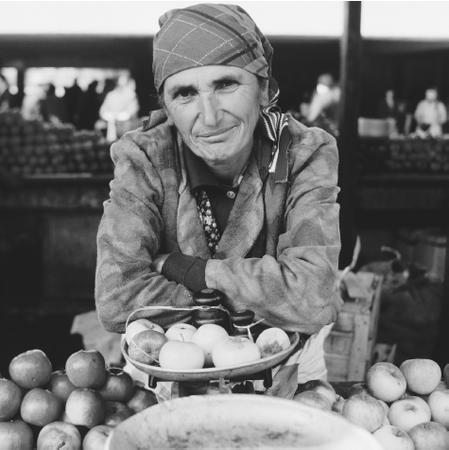
An apple seller in Tbilisi. A wide variety of fruits are grown in Georgia, although arable land is limited.
identity is a strong cultural factor that defines the prevailing system of social values. The majority of Georgians in Ajara are Sunni Muslims, as are a few inhabitants of the Meskheti region. There are also Shiite Muslims among the Turkic inhabitants in the southeast (Azeris) and Sunni Muslims among the Abkhaz, Ossetians, and Greeks. Several Protestant churches are active, with the Baptists being the most successful. Most ethnic Armenians belong to the Gregorian Christian Church. There are small groups of Yezid Kurds, Russian Molokans and Dukhobors, and Jews; the population of the latter two groups has diminished because of emigration. New emerging cults and sects, such as Jehovah's Witnesses, meet with hostility and aggression from the established churches and the population.
Rituals and Holy Places. The great majority of Orthodox religious ceremonies are carried out by priests in churches. The most important ceremonies, especially those celebrating Easter and Christmas, are carried out by the Patriarch in Svetitskhoveli Cathedral in the ancient town of Mtskheta, or in the Zion Cathedral in Tbilisi. Daily
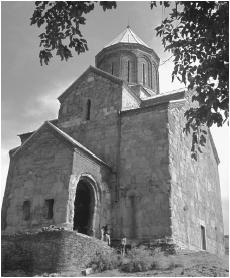
Most Georgians belong to the Georgian Orthodox Church. Daily services are held, but many seldom attend.
services are held in churches, as well as weddings and baptisms. In some cases priests are invited to other places to bless new initiatives, buildings or organizations. Many people claim to be religious but seldom attend religious ceremonies. In mountainous regions, people who self-identify as Christian continue to follow rituals of pagan origin.
Death and the Afterlife. Many of popular beliefs and rituals regarding death and afterlife stem from a mixture of Christian and pagan concepts, with many superstitions and cultural borrowings. Respecting the deceased is a very important part of social life, and much time is spent attending funerals and wakes and caring for graves. Although people believe in an eternal afterlife, there is no clear understanding of its nature; people observe rules and try to reduce their grief by ritualizing the mourning process.
Secular Celebrations
The most widely observed holiday still is the New Year. Among national holidays, Independence Day is the most respected, and people like to attend even newly invented festivities such as Tbilisoba in October, a holiday invented by the Communist authorities.
The Arts and Humanities
Support for the Arts. Although the state is supposed to support arts through the Ministry of Culture, there are few funds that rarely find the proper application. Some professional unions, once controlled by the government, continue to claim state support despite contributing little to cultural life. Artists whose work depends less on linguistic restrictions, such as painters and craftsmen, look for financial support and markets abroad. Many writers and artists work in politics or business or try to couple them with their art; it is not uncommon for film makers and writers to have a position in the parliament or other agencies of the government.
Literature. Literature is in a dire condition because of the political and economic crisis that started long before independence. There are only a few young talented writers and poets and almost none from the older generation. The literary market is dominated by translations of bestsellers, detective stories, and erotica.
Graphic Arts. Graphic arts are popular, and many young artists are demonstrating high levels of creativity and skill. Many artists sell their work in the West.
Performance Arts. The performance arts are in a crisis because limitations imposed by language hinder the art from finding a wider audience. Several ballet dancers, opera singers, and theater directors have achieved success in other countries. However, in Tbilisi, performance art and dramatic art are alive and rich.
The State of the Physical and Social Sciences
Physical and natural sciences, along with engineering, were highly developed in the Soviet period because of their application to defense. Today there is next to no funding in these areas, as most Western aid goes to the social sciences. This has caused many scientists to emigrate, and the brain drain has helped maintain relations with leading scientific institutions. The social sciences were underdeveloped in the communist era and have not reached international standards in teaching and research.
Bibliography
Allen, W. E. D. A History of the Georgian People from the Beginning Down to the Roman Conquest in the Nineteenth Century, 1932, 1971.
Alpago, Novello. Art and Architecture in Medieval Georgia, 1980.
Aronson, Howard I. Georgian: A Reading Grammar, 1982, 1991.
Ascherson, Neal. Black Sea: The Birthplace of Civilisation, 1996.
Avalov (Avalishvili), Zurab. The Annexation of Georgia to Russia, 1982.
——. The Independence of Georgia in International Politics: 1918–1921, 1940, 1982.
Aves, Jonathan. Georgia: From Chaos to Stability, 1996.
Braund, David. Georgia in Antiquity: A History of Colchis and Transcaucasian Iberia, 1994, 1996.
Charachidzé, Géorges. Prométhée ou le Caucase: Essai de Mythologie Contrastive, 1986.
Chatwin, Mary Ellen. Socio-Cultural Transformation and Foodways in the Republic of Georgia, 1996.
Chervonnaya, S. Conflict in the Caucasus: Georgia, Abkhazia and the Russian Shadow, 1995.
Crego, Paul. "Religion and Nationalism in Georgia." Religion in Eastern Europe 14 (3): 1–9, 1994.
Curtis, Glen E., ed. Armenia, Azerbaijan and Georgia: Country Studies, 1995.
Gachechiladze, R. The New Georgia: Space, Society, Politics, 1995.
Gamkrelidse Thomas V. Alphabetic Writing and the Old Georgian Script: A Typology and Provenience of Alphabetic Writing Systems, 1994.
Georgia: A Travel Reference Map of the Republic of Georgia, 1997.
Grigolia, A. Custom and Justice in Caucasus: Georgian Highlanders, 1936, 1939, 1977.
Herzig, Edmund. The New Caucasus: Armenia, Azerbaijan and Georgia, 1999.
Kazemzadeh, Firuz. The Struggle for Transcaucasia (1917– 1921), 1951, 1981.
Lang, D. M. The Georgians, 1966.
MacFarlane, S. Neil. "Democratization, Nationalism and Regional Security in the Southern Caucasus." Government and Opposition 32 (3): 399–420, 1997.
Melikidze, V., and G. Tarkhan-Mouravi. Human Development Report: Georgia 1997, 1997.
Mepisashvili, Rusudan, and Tsintsadze Vakhtang. The Arts of Ancient Georgia, 1979.
Nasmyth, Peter. Georgia: Mountains and Honour, 1997.
Rayfield, Donald. The Literature of Georgia: A History, 1994.
Rosen, Roger. The Georgian Republic, 1995.
Schrade, Brigitta, ed. The Art of Svanetia: Medieval Treasures from the Caucasus, 2000.
Suny, R. G. The Making of the Georgian Nation, 1989, 1996.
Toumanoff C. Studies in Christian Caucasian History, 1963.
Toumanoff, Cyril. "Medieval Georgian Historical Literature (VIII–XV Centuries)." Traditio 1: 139–182, 1943.
